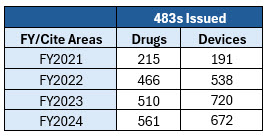How AI Is A Game-Changer For Auditing Compliance And Efficiency
By Jesper Madsen Wagner and Thomas Bo Sølver, NIRAS

The number of warning letters and Form 483s issued by the FDA has increased dramatically over recent years. Between FY2021 and FY2024, there was a 161% rise in 483s for drugs and a 252% rise for medical devices.1 This indicates that quality audits are more important than ever.

Table 1: FDA Inspection Observation
As regulatory scrutiny intensifies, companies must find more efficient ways to ensure compliance. This is where artificial intelligence (AI) comes into play, transforming industries across the globe — including quality auditing. Imagine a world where audits are completed in half the time with twice the accuracy. This is the promise of AI-driven tools like ChatGPT.
From planning to execution and reporting, AI is changing the way auditors operate, making compliance more seamless than ever. However, with great power comes great responsibility. While AI offers undeniable advantages, it also presents risks that require careful oversight.
AI In Auditing: A New Era Of Efficiency
Audits have long been bogged down by repetitive tasks — drafting reports, verifying documents, and ensuring compliance with complex regulatory frameworks. AI is revolutionizing the game by automating these processes, enabling auditors to concentrate on high-level analysis and informed decision-making. With smarter planning, AI reduces busywork, paving the way for real-time assistance during audits.
1. Smarter Planning, Less Busywork
Imagine an audit where most of the prep work is done for you. AI can:
- generate detailed audit plans aligned with industry standards
- create customized checklists based on real-time regulations
- gather background information on suppliers and past audit trends.
For instance, an AI-generated audit plan for a supplier might break the day into structured segments — document reviews, process evaluations, and product inspections — ensuring nothing falls through the cracks. The use of AI is beneficial not only during the planning phase but also throughout the actual audit.
2. Real-Time Assistance During Audits
Gone are the days of flipping through stacks of regulatory documents. AI provides auditors with:
- dynamic checklists that adapt as findings emerge
- instant access to compliance rules and industry best practices
- automated documentation that logs observations and discrepancies in real time.
This means an auditor spotting mislabelled products or missing maintenance records can immediately check compliance protocols and generate corrective action steps on the spot.
3. Faster, More Reliable Reporting
Once the audit is complete, AI streamlines reporting by:
- structuring findings into professional, standardized reports
- ensuring consistency and reducing the chance of human error
- tracking corrective actions and follow-ups effortlessly.
For example, suppose a company’s approval labels are not under the proper control of quality control (QC). In that case, AI can not only flag the issue but also suggest corrective actions and set deadlines for compliance.
Why AI is A Game-Changer For Auditors
- Saves Time: Tedious administrative tasks become automated, freeing auditors for strategic work.
- Boosts Accuracy: AI minimizes errors in compliance checks and documentation.
- Enhances Compliance: By cross-referencing regulations in real time, AI ensures nothing is overlooked.
- Scales Easily: AI enables audits to be conducted across multiple locations without additional manpower.
The Human Element
While AI is revolutionizing auditing, it is crucial to emphasize the importance of human auditors and their intuition. Although AI and digitalization are transforming our work, the human element has become increasingly vital. Auditing involves more than merely reviewing documentation; it also verifies that processes are adhered to correctly and that the appropriate production environment is established, maintained, and properly used. A gut feeling that something is amiss can arise from a subtle observation that does not quite add up during interviews or factory tours that does not quite add up.
Supplier audits assess the credibility of the organization being audited and determine whether it can genuinely be trusted. Unfortunately, experienced auditors can recount stories that most would find hard to believe, from monkeys running amok in a pharmaceutical warehouse to documentation from the sterilization process that never actually took place and departments tied to companies whose sole purpose was to fabricate fraudulent documentation and data.2
The Dark Side Of AI In Auditing
But it’s not all smooth sailing. AI’s reliance on existing data means it can sometimes misinterpret industry-specific nuances. Moreover, there’s another, more sinister risk: misuse. With AI capable of generating convincing yet false documentation, companies must remain vigilant against fraudulent reports. Laboratory data can be produced that appears reliable, and certificates with official stamps are easily fabricated. Therefore, cross-checking and data verification are becoming increasingly important. The authenticity of an ISO certification can be verified, for instance, by checking the certification body's official website. Analytical results in reports can, for example, be checked by inspecting the data from the analytical instrument and ensuring data integrity measures are in place (audit trail review).
What’s Next? AI And The Future Of Auditing
AI’s role in auditing is only just beginning. As machine learning evolves, we can expect even more advanced capabilities, such as predictive analytics that flag potential risks before they become compliance violations. However, one thing is clear: AI should assist, not replace, human auditors. The key to success lies in finding the right balance between automation and human expertise. AI also relies heavily on data being electronically available. Despite digitalization and its increasing implementation in companies, many organizations still rely on traditional paper methods for generating production records, indicating there is still a long way to go for these businesses.
Final Thoughts
The auditing landscape is undergoing a seismic shift, and AI is at the centre of it all. By embracing AI-driven tools while maintaining rigorous oversight, auditors can work smarter, faster, and with greater precision. However, ensuring that AI is used responsibly will be critical in maintaining the integrity of audits in an increasingly digital world.
References
- The FDA Group, FDA Warnings Letters & Inspection Observation Trend
- Katherine Eban, Bottle of Lies: The Inside Story of the Generic Drug Boom, 2019
About The Authors:
 Jesper Madsen Wagner is the expertise director for medical devices at NIRAS. He has over 25 years of experience in quality and software compliance for computer systems in the life sciences industry. He specializes in manufacturing, GDP, automation, supplier control, and process validation. With extensive knowledge of global medical device regulations — including ISO 13485, ISO 9001, EU MDR/IVDR, and MDSAP — he has conducted audits worldwide. A recognized speaker at the ECA and a member of the Qualification and Validation expert group, Jesper has held leadership roles in life sciences and consultancy firms. He holds an M.Sc. in chemical engineering from DTU.
Jesper Madsen Wagner is the expertise director for medical devices at NIRAS. He has over 25 years of experience in quality and software compliance for computer systems in the life sciences industry. He specializes in manufacturing, GDP, automation, supplier control, and process validation. With extensive knowledge of global medical device regulations — including ISO 13485, ISO 9001, EU MDR/IVDR, and MDSAP — he has conducted audits worldwide. A recognized speaker at the ECA and a member of the Qualification and Validation expert group, Jesper has held leadership roles in life sciences and consultancy firms. He holds an M.Sc. in chemical engineering from DTU.
 Thomas Sølver is a pharmaceutical quality expert and lead auditor at NIRAS. He has extensive experience in global audits, GMP compliance, and tech transfer, with a strong focus on quality systems and regulatory requirements across the pharmaceutical value chain.
Thomas Sølver is a pharmaceutical quality expert and lead auditor at NIRAS. He has extensive experience in global audits, GMP compliance, and tech transfer, with a strong focus on quality systems and regulatory requirements across the pharmaceutical value chain.
